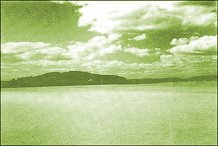
Flats are shallow, relatively level expanses bordering deeper water. They may be found "outside," along the ocean front or "inside," bordering an estuary or perhaps within a large bay or near a river's mouth. Flats may be large, covering many acres of water, or they may be small, being only a few hundred yards in area. Their bottoms may be light and sandy, as is usually the case with outside flats, or they may be dark and muddy, which is often the way it is with many inside flats. Whatever their size or composition, inside or outside, flats are almost always fertile places to fish.
Flats can be mysteries to many - simply because of their seeming flatness. I say "seeming" because no flat is ever truly flat throughout its entire expanse. There are always depressions, holes, and ridges, as well as edges to these flats. In addition, most flats will have some mussel or clam or weed beds and other places of structure. Try to make your first visit to a flat at low tide so that you can see it when it's bare of cover, so that you can see its basic "structure."
Walking across a flat for the first time, one of the first things you want to look for is the "drop off," the edge of the flat, where the shallows end and the deeps begin. These "deeps" may be a river or estuary channel if you're fishing an inside flat or they may be the harbor or ocean depths if you're fishing "outside." It's here that much striper activity will take place, especially on the low falling or low incoming tides. And it's here that your fishing should be concentrated at this time.

Protected from the coastal winds and rough seas, inside flats tend to be more stable than outside flats. Inside sand flats can be a sight-fisherman's dream. Dark figures coming in over the bright white sand in lower center of photo are stripers, probably looking here for crabs or shrimp.
Later, as the tide rises, the fish will move up out of the channel or depths and onto the flat in search of food. If you've been on the flat since low tide and have taken note of the bottom and any structure (mussel beds, rocks, etc.) you can reasonably predict that stripers will sooner or later put in an appearance at these places and it's a good idea to position yourself close to these places so that you'll be ready for them when they appear. It's also a good idea to train your eyes so that you can see fish as they come over the flats. A good pair of polarized glasses can be an enormous help here.
At some point, the rising tide will considerably limit your access to many of the productive places that you were able only an hour earlier to fish with ease and will force you to fish closer to shore. This is the bad news - especially if you misjudge the speed or height of the incoming tide and find yourself suddenly swimming towards shore. The good news is that the rising tide will at the same time increase accessibility for the stripers coming up onto the flat, allowing them to move in closer to shore to feed around the eel grass and weed beds and other places that might harbor baitfish, shrimp, or other types of food. At the higher stages of the tide, then, you should spend most of your time fishing the "inner" edges of the flat closer to shore, casting along the edges with a baitfish or shrimp imitation or with a surface fly.
Signs to Watch For
As the tide moves in and you're wading over the flat in search of stripers, it's generally best to keep your eyes relatively unfocused so that your peripheral vision takes in a broader view. Let your eyes become accustomed to both the rhythms of the surface as well as to the general nature of the bottom, so that they become visually familiar. When your eyes detect something - anything - that doesn't belong in the picture your mind's eye has formed a moving shadow, for example, or a flash of silver, a puff of sand, a ripple on the surface, perhaps even a small patch of darkness standing out against a light bottom, then it's time to focus your eyes more closely to determine if what you've just seen might be a fish. It often is.

A small inflatable raft is one of the handiest items a wading flats fisherman can bring with him. It'll allow you greater freedom (you can stay out on the flat for a longer period of time) and will also provide you with the means to return to shore safely. I almost always take one with me and stake it out in a place that I can wade to easily when the tide begins to rise.
Whatever stage of the tide you happen to be fishing, be on the watch also for actively feeding fish or for signs of feeding fish. Birds diving into a school of baitfish or baitfish popping out of the water are two of the most common indications that stripers may be feeding beneath. Striper tails projecting up above the surface are a sure sign that the fish are feeding on the bottom, digging their noses into the mud for crabs, worms, clams, or any other food they may find there.
When the tide is fairly low, only a foot or so deep at the most, look also for fish wakes, for bulges caused by stripers pushing up water from below. These bulges are usually quite visible when the water is calm, but when the water's surface is rough, it takes a trained eye to detect them. If you do detect wakes, try to position yourself so that you can cast in front of them as they pass by. If this isn't possible, cast to the near side of the fish that's closest to you.
As you're wading and wandering across the flat, it's very important to remember to wade carefully and very quietly, disturbing the water as little as possible. Stripers that are moving out of the deeps and into the shallows will be predictably more cautious as they make this transition. If it's necessary to get down on your knees at times to cast to a shallow-feeding striper, then do so. Your chances for success will be much greater if the striper is unaware of your presence.






